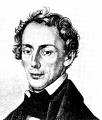Doppler Effect
LESSON PLAN
Title of
lesson: Which Pitch?
Topic: The Doppler Effect
Grade level/s: 9-12
Time needed: One 45 minute period
Science or Math background material for the teacher:
The instructor should be familiar with the Doppler effect and the concept of wave theory. Wavelength, amplitude, frequency and wave speed are important concepts for the effective instruction of this lesson
Instructional Objectives:
Students should be able to:
1. Identify the Doppler effect with sound and graphical images.
2. Predict the effect of velocity and movement on the frequency and wavelength of waveforms.
National Science Education Standards met by this lesson:
CONTENT STANDARD B: As a result of their activities in grades 9-12, all students should develop an understanding of
* Motions and forces
* Conservation of energy and increase in disorder
* Interactions of energy and matter
Materials: The instructor will need:
· A computer with an internet link and speakers
· The sound bites provided in
· The Doppler Effect worksheets provided in
Motivation: As a motivational activity, the sound bites should be played to demonstrate the Doppler effect without actually labling it as such. The instructor can ask the students questions about the sounds, and provoke a response that describes how the frequency changes as a moving vehicle passes a stationary observer. Sound Clip with music. Sound Clip without music.
Procedure:
The instructor should play the above sound clip using speakers attached to a computer. Initially, the music should grab the attention of the students, but should not be the focus of the lesson.
After playing the sound clip, the instructor should play the sound effects without the music in the foreground.
After invoking the description of the frequency change, the instructor should define the Doppler effect: the change in the frequency of emitted waves due to the change of distance between the observer and the source.
The Doppler links are good visual aids used to describe the effect for students who are visual and graphical learners. They should be played to demonstrate not only the change in frequency of the waves, but also the change in wavelength.
Included with this lesson is a packet of questions to be ansewered as the lesson progresses. Question two asks the students to draw pictures that demonstrate the change in wavelength of the waves as the distance between the source and observer changes.
As an extra demonstration, a tuning fork on a string can be spun around the head of the instructor. As the fork approaches the students, they should hear an increase in pitch. As the fork receeds from the students, they should hear a decrease in pitch.
Question three asks the students to describe why the teacher hears no pitch change as the fork spins. Since the distance between the fork and the instructors ears is constant, no change in frequency is apparent.
Question four describes redshift and blueshift, as it applies to moving light sources. Since light acts as a wave, as the distance between a light source and an observer changes, the frequency of the light will change just as sound waves do. Redshift is the lengthing of wavelengths of light, and blueshift is the reduction of the wavelength. Students should be able to determine whether an object is moving toward or away from an observer, based on the red or blue shift of the light.
Four regents questions are included at the end of the lesson to be used as independent practice and assessment.
Adapatations for students with disabilities:
The lesson is designed to appeal to varius types of learners. Those who are visually impared can still learn the topic, as much of the explanations are based on the change in pitch. Those who are hearing impared should be able to grasp the topic through the visual components.
Possible ways technology might be incorporated:
This lesson is inherently technology based. The computer will be used for several parts, as the applets will be projected, and the sound effects will be played over its speakers.
Assessment
The learning of the students can be assessed by way of the questions at the end of the packet. At least one problem should be saved for this purpose.
Bibliography/References:
http://www.lon-capa.org/~mmp/applist/doppler/d.htm
http://library.thinkquest.org/19537/java/Doppler.html